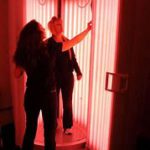Last Updated on 12 months by Francis
https://www.youtube.com/watch?v=S5zmQCrcS80
Red light therapy is a form of low-level light therapy that is used for a variety of health and wellness purposes, including skin treatments, pain relief, and muscle recovery. This therapy involves exposing the body to red light wavelengths, which are thought to stimulate the natural healing processes within the body. In this article, we will explore the science behind red light therapy, including how it works, what benefits it may offer, and what research has been done on this increasingly popular form of alternative medicine.
Contents
Red Light Therapy: An Overview
Red light therapy (RLT) is a non-invasive form of therapy that utilizes red and near-infrared light to penetrate the skin and stimulate cellular function. Red light therapy is also known as photobiomodulation (PBM) therapy or low-level light therapy (LLLT). The use of RLT has been studied and is believed to have therapeutic effects on a wide range of conditions, including skin disorders, pain management, and wound healing.
The History of Red Light Therapy
The therapeutic use of light dates back centuries. Ancient Greeks, Egyptians, and Chinese civilizations used sunlight to treat various ailments. The modern-day discovery of RLT started in the 1960s when researchers found that low-level laser light had a positive effect on wound healing.
How Does Red Light Therapy Work?
Red light therapy works by stimulating the mitochondria in our cells. Mitochondria are responsible for producing energy in our cells. When exposed to red light, the mitochondria produce more ATP (adenosine triphosphate), which is the energy that our cells use to function. The increased ATP production promotes cellular repair and regeneration, which can lead to therapeutic benefits.
Red light therapy (RLT) is a non-invasive form of therapy that uses red and near-infrared light to stimulate cellular function, which can lead to therapeutic benefits such as pain management, skin rejuvenation, and wound healing. RLT works by increasing circulation and reducing inflammation, and it can promote wound healing by increasing ATP production. Although it is generally considered safe, there are some risks associated with its use, such as eye damage, skin damage, and interference with photosensitive medications.
The Mechanisms of Red Light Therapy
Red light therapy works by increasing circulation and reducing inflammation. The red and near-infrared light penetrate the skin and promote cellular metabolism, which leads to increased blood flow and oxygenation. The increased circulation can reduce inflammation and improve wound healing. Additionally, red light therapy can stimulate collagen production, which can lead to improved skin health and reduced wrinkles.
The Benefits of Red Light Therapy
RLT has been shown to have a wide range of therapeutic benefits, including pain management, skin rejuvenation, and wound healing.
One key takeaway from this text is that red light therapy is a non-invasive form of therapy that utilizes red and near-infrared light to stimulate cellular function and promote healing. It works by increasing circulation, reducing inflammation, and stimulating the production of collagen. RLT has been shown to have therapeutic benefits for pain management, skin rejuvenation, and wound healing, among other potential benefits. However, it is important to be aware of the risks associated with its use, such as eye and skin damage, and to consult with a healthcare provider before using RLT if taking photosensitive medications.
Pain Management
RLT has been shown to be effective in managing pain associated with arthritis, back pain, and muscle soreness. The increased circulation and reduced inflammation can alleviate pain and promote healing.
Skin Rejuvenation
RLT can improve the appearance of the skin by reducing wrinkles, fine lines, and scars. The increased collagen production can lead to improved skin texture and tone.
Wound Healing
RLT can promote wound healing by increasing circulation and reducing inflammation. The increased ATP production can also promote cellular repair and regeneration, which can accelerate the healing process.
Other Benefits
RLT has been studied for its potential benefits in treating depression, improving sleep, and reducing hair loss.
The Risks of Red Light Therapy
RLT is generally considered safe, but there are some risks associated with its use.
Eye Damage
RLT can damage the eyes if proper eye protection is not used. It is important to always wear appropriate eye protection when using RLT devices.
Skin Damage
RLT can cause burns or skin damage if used incorrectly. It is important to follow the manufacturer’s instructions when using RLT devices.
Interference with Photosensitive Medications
RLT may interfere with photosensitive medications, such as certain antibiotics or chemotherapy drugs. It is important to consult with a healthcare provider before using RLT if you are taking photosensitive medications.
FAQs for “What is the science behind red light therapy?”
What is red light therapy (RLT)?
Red light therapy (RLT) is a form of phototherapy that uses low-level red wavelengths of light to promote healing, skin rejuvenation, pain relief, and other health benefits. It involves exposing skin to red light in the range of 630-660 nanometers, which can penetrate the top layers of skin and stimulate cellular activity at the mitochondria level.
How does RLT work to promote healing and improve health?
Studies have shown that red light penetrates the skin and activates mitochondrial function, which enhances cell metabolism and energy production. The increased cellular energy can accelerate tissue repair, boost circulation, and reduce inflammation. Red light therapy also triggers the body’s natural healing mechanisms, including the release of endorphins and other growth factors that promote tissue regeneration and pain relief.
What are the health benefits of RLT?
Research has found that red light therapy can improve a range of health conditions and issues, including skin aging, acne, wound healing, inflammation, pain relief, arthritis, muscle recovery, and depression. RLT can also increase natural collagen production in the skin, which can reduce the appearance of wrinkles and fine lines.
Is RLT safe and effective?
Red light therapy is generally considered safe and has few to no side effects. However, it’s important to follow proper protocol when using RLT devices, such as wearing protective eyewear, limiting exposure time, and using devices that have been tested and certified for safety. While many users report positive results with RLT, it’s important to note that individual results may vary and the therapy may not work for everyone.
How can I use RLT at home?
There are a variety of RLT devices available for home use, including handheld devices, light panels, and full-body beds. These devices typically provide red light therapy in the 630-660 nm range and can be used for short sessions (typically 10-20 minutes) several times a week. It’s important to read and follow the instructions for any device you use and consult with a healthcare provider if you have any underlying health conditions.







